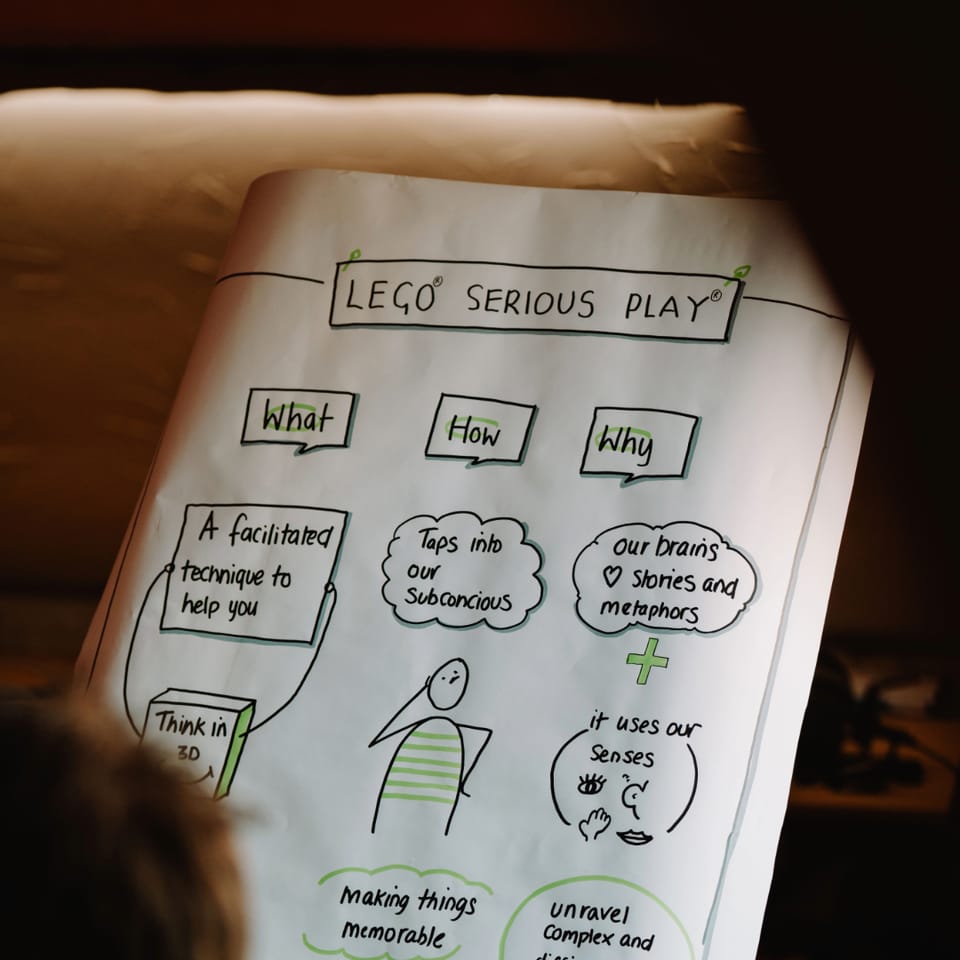From Doodles to Design: My Journey with Sketchnoting

Ever feel like you’re just not creative enough? That was me not too long ago. Can you believe I started as a designer who couldn't draw a convincing stick figure? Yep, true story. Stick around, and I’ll share how I went from feeling like an impostor in a room full of talented artists to leading workshops with bold visual flipcharts.
If you're a creative, facilitator, teacher, or just someone curious about visual learning, I hope my story inspires you to pick up a pen and give sketchnoting a try.
What Is Sketchnoting?
Sketchnoting is a creative way to take notes using a mix of handwriting, drawings, shapes, and layouts. Whether you're jotting down ideas during a meeting or capturing key points from a podcast, sketchnoting turns ordinary notes into visually engaging and memorable stories.
For me, it’s been a total game changer—especially as a kinaesthetic learner who thrives on doing rather than simply listening. Science backs this up too! According to various studies drawing boosts memory retention significantly compared to writing. Visuals don’t just enhance understanding—they stick.
Where It All Began
I’ll never forget my first few months as a junior UX designer at a game studio. Everyone around me could whip up jaw-droppingly gorgeous manga art in seconds, while I awkwardly scribbled questionable stick figures to explain my ideas. It was humbling… and, frankly, mortifying but I was encouraged to seek out my creativity by drawing more, so instead of retreating into my comfort zone, I decided to tackle a mini sprint to tackle this weak spot. I started small with a 100-day challenge to draw icons every day. Some of those early drawings? Laughable and odd, animals, hands and stars are not my strong point. But over time, I built a “visual vocabulary” and started feeling more confident.
Sketchnotes Meet Journaling
Next, I combined sketchnoting with journaling. Those tiny daily doodles turned into more cohesive visual stories. Gradually, I started using sketchnotes more in my day to day life. Creating to do lists, to shopping lists, and even using it to record D&D game adventures.
As I immersed myself into a world of sketchnoting I started to follow different groups and people and got more embedded into the world of sketch notes and then graphic facilitators and graphic recorders.
From Notes to Flipcharts
With every workshop I facilitated, I realised how powerful visuals could be. That’s when I experimented with creating large-scale visual posters instead of traditional slide decks. The response was amazing—participants stayed more engaged, and the analogue setup really encouraged creativity and collaboration.
There were growing pains of course! Like learning how to line up text without a ruler or mastering marker techniques. (The struggle between chisel tips and round tips, am I right?!) But practice led to progress, and today I create bespoke flipcharts tailored to each client.
Discovering Visual Facilitation
An accidental LinkedIn deep-dive introduced me to graphic visual facilitation. I connected with inspiring professionals in the field, took a few courses, and gradually added graphic recording to my repertoire. Watching experienced facilitators create a vibrant, flowing summary of a 3-hour workshop was so amazing to experience - it gave me something to aspire to.
Tips for Beginners
Thinking about giving sketchnoting a go? Trust me, you don’t need to be an artist. Here’s how you can get started (without the intimidation):
🎨 Start Small
Grab a pen and paper, and doodle for five minutes every day. It could be a simple icon, a favourite quote, or a quick mind map. It’s all about building habits.
🎨 Use Resources
There are loads of free sketchnoting tutorials and books out there. My personal favourites? “The Sketchnote Handbook” by Mike Rohde and YouTube tutorials by visual thinkers like LooseTooth
🎨 Attend Courses
I learned so much by joining a visual facilitation workshop. Even a weekend course can give you foundational skills and motivate you to keep going. Thank you to the two trainers Charles-Louis and Marcus De Vale for the Bikablo course which really moved me forward.
🎨 Experiment with Tools
Try out different notebooks, markers, and colour palettes until you find what works for you. I swear by chisel-tip markers now—but only after a few awkward learning moments! My new found love of Neuland markers.
🎨 Join Communities
Follow hashtags like #Sketchnoting and #VisualFacilitation on LinkedIn or Instagram. The support and inspiration in these communities are phenomenal.
🎨 Be Kind to Yourself
Remember, this is a process. Your first attempts might look… less than perfect, but that does not matter. With consistency, you’ll see growth—even if it’s just recognising your style.
Why It Matters
Sketchnoting isn’t just about creating pretty visuals. It’s a tool to enhance learning, fuel creativity, and communicate ideas more effectively. And, as someone who thrives on connecting with learners and workshop participants, I can't overstate its impact.
Want proof? 💡 The next time you're running a meeting or learning something new, try incorporating just one visual element. It might be an icon, a bold headline, or colour coding your notes. Watch how it shifts your level of engagement and memory recall.
Take That First Step!
If you’re ready to explore the wonderfully playful world of sketchnoting, why not take the plunge with a gentle push? Subscribe to my Sketchnote Newsletter for monthly tips, resources, and (hopefully) a spark of inspiration to fuel your creative fire.
Remember, every bold visual starts with a single, imperfect doodle. Pick up that pen—you've got this! 🎉
FYI - I currently have a poster up in my bathroom where any random thought or idea can just be doodled - a lot of inspirational ideas come to my mind when I am relaxing in the bath. So find places around your home to brighten up with your sketches and doodles.